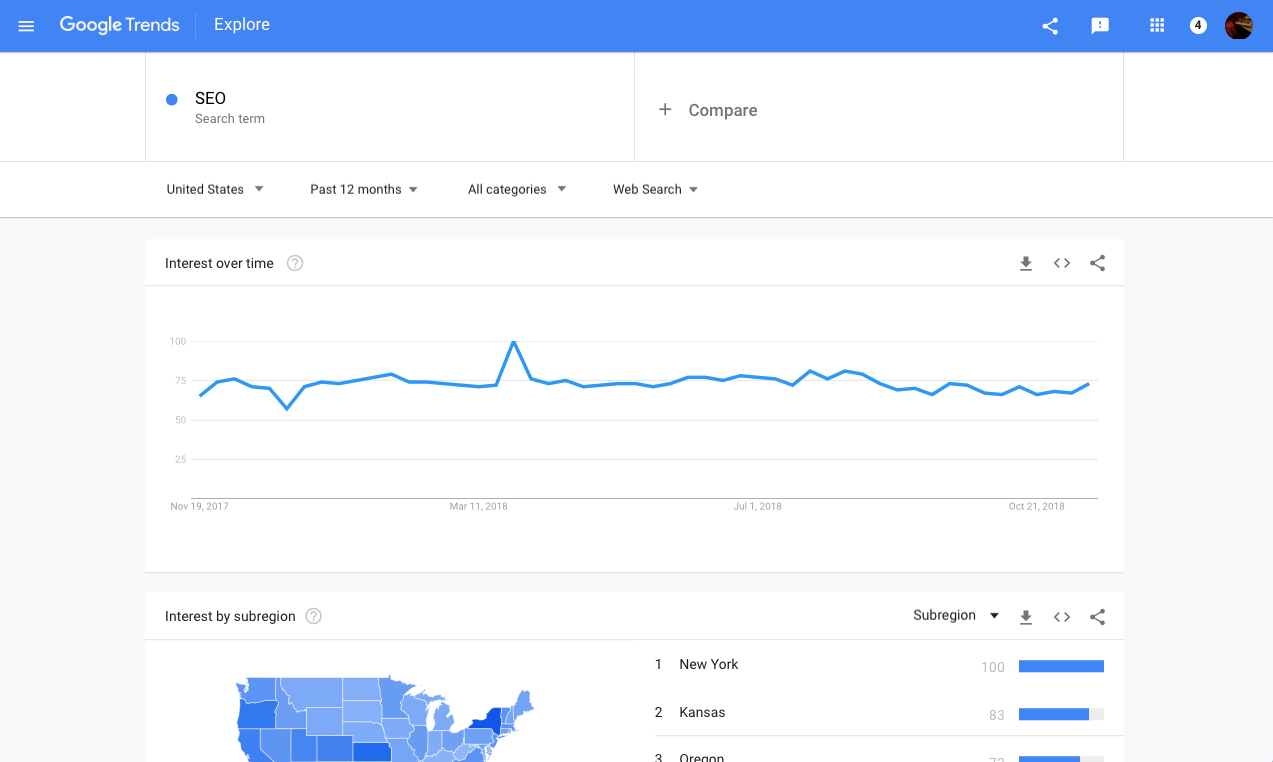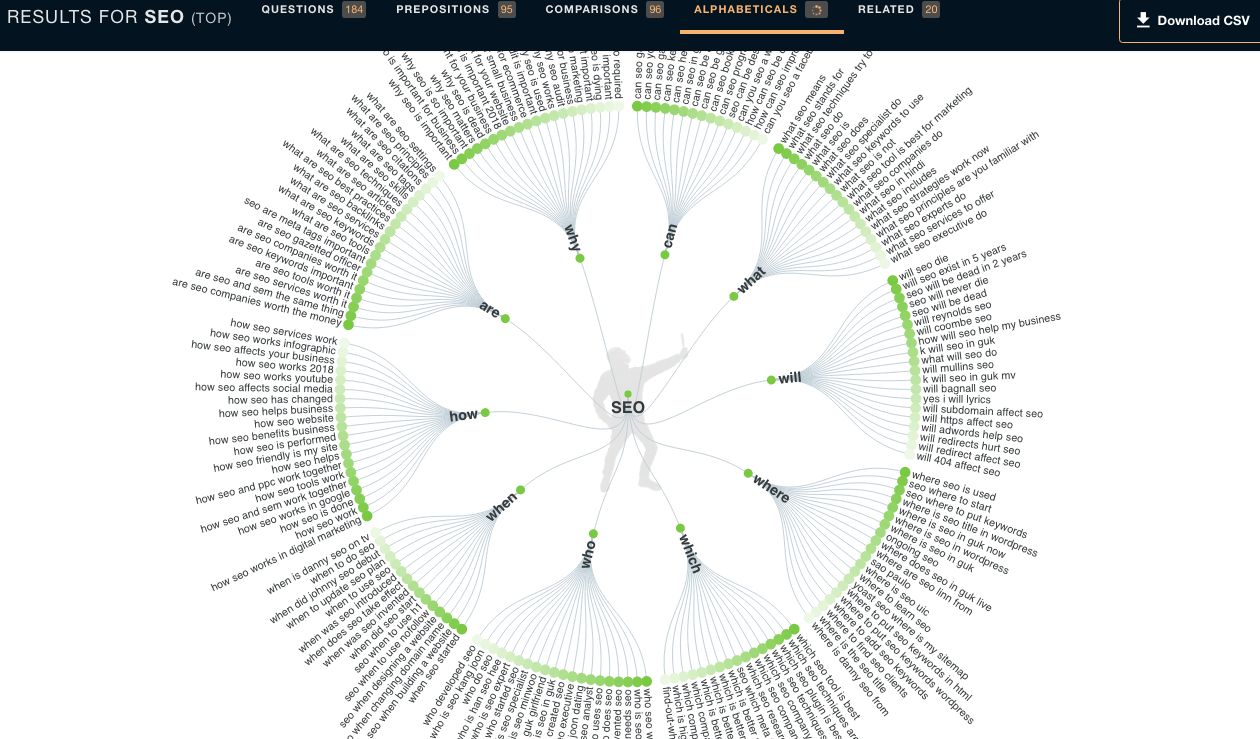Keeping up to date with what people search for online can be invaluable to your business. Whether you’re looking to inform your latest paid search campaign or just need some fresh, trending content for your blog, these tools can help.
However, with over 3.5 billion searches each day worldwide, it’s hard to know how to narrow all that data down to help you improve your SEO.
Here are some of the many great tools available to help you discover what people search for: the most popular topics, keywords, and trending stories.
Google Trends
When asking what people search for, it makes sense to start with the largest, most commonly used search engine in the world – Google. Due to its sheer size, Google has some great stats, trends, and insights to dig your teeth into.
Let’s look at Google Trends, for example. This gives you a very quick overview of the searches with the most traffic overall, which is continually updated. You can enter a keyword and see how search volume has varied for that term over time and in different places.
Simply change the location, time frame, category and type of search to dig even deeper into the data.

Google Trend results for “SEO.”
Google Autocomplete
If you’re looking to find variations in your keyword phrases, Google Autocomplete is a great free tool that you’re probably already using every day.
Type your keyword into the search box and related terms will display in a drop down list. This can be a good starting point for inspiration on long-tail keywords you might need.
Google News
If you’re looking for fresh content for a website or blog, Google News will deliver the very latest headlines from news sites across the globe (including local news), which are tailored to your personal interests/keywords.
You can use the search bar and the “top stories” section on the left side bar. Also, you can zero in on specific topics and locations to see what news stories people are reading and searching for now.

Google News results for “Brexit.”
Trending on social media
Away from Google related tools, there is plenty that the big social media platforms can offer you when it comes to updates on the latest trends. Regular users of Twitter will know about the trends for you box, which uses an algorithm to display trends that are based on your location and who you follow.

This is similar to Instagram’s Explore function. Again, it’s based on your Instagram history and the type of content you follow and watch.
When it comes to broader discovery of what people search for, trending hashtags on both Twitter and Instagram are invaluable. Simply start researching the day’s top performing hashtags to see what‘s hot and then follow the conversation – perfect for blog post topics.
Ask Quora
Of all the question and answer sites, Quora is one of the most useful tools for long tail keywords research. Its “related questions” feature (which appears once you’ve typed in a question) is a handy way to generate long tail keywords that might not immediately spring to mind from just looking at your search term. But more importantly, whatever topic you plan to cover, Quora has relevant questions and corresponding answers from thought leaders in that field.

Quora’s title page with related questions box.
Answer the Public
One of our favorite but lesser-used tools is Answer the Public.
Answer the Public utilizes search data from Bing and Google and predicts what questions will be asked around each keyword. It also presents this data in a unique and visually stunning way – plus you’re able to download the information to an Excel or .CSV file.

Answer the public’s beautiful data presentation.
Bing Webmaster Keyword Research Tool
Poke around with what people search for with Bing’s own data on its organic searches. The tool provides up to six months of search data (no averages) and generates suggestions of keywords by language and country/region.
For more information on this tool, check out our previous guide, Bing Keyword Research Tool: Highlights & Limitations.
Bing Ads New Trending Queries and Broad Match
This tool allows you to discover what people search for by industry and sub-industry. You select your target audience, and it populates new trending queries (by volume) on the left bar.
Then, you can click any given query to see how it’s performed this year versus last year and how popularity changes week to week.

Google Ads Keyword Planner
Most of us are already familiar with Google Ads (formerly AdWords) Keyword Planner. Search for keyword ideas, compare how keywords perform, measure the keyword competition and improve your next campaigns.
For more information on using Gooogle Ads, check out these articles:
- The end of DoubleClick and Adwords? Google simplifies its branding with Google Ads, Marketing Platform and Ad Manager
- Using the new Google AdWords dashboard
- An introduction to advanced audience targeting in AdWords
- The Google AdWords training courses you need ASAP
- What is an AdWords Quality Score and how can you improve yours?
End of year summaries
If you want to explore the searches that have shaped the previous year, most of the major search engines will summarize this data for you. For example, Google’s Year in Search will give you a top 5 list in a variety of topics – from actors, car brands and consumer tech, to movies, recipes, and even selfies!
Click on any of the results to be taken to an Explore page to see more information, such as interest by region, related topics and related queries – giving you a heap of great insights.
What other of your favorite tools did we miss? Leave a comment below!
The post What people search for: Tools for trends appeared first on Search Engine Watch.